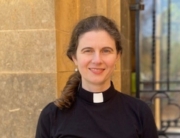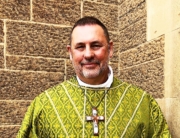Easter 3, 15th April 2018
The Very Rev’d Frank Nelson
Ezekiel 37: 15 – 28
A Song to the Lamb
Revelation 19: 4 – 10
It was Easter at St George’s Cathedral, Cape Town that I first consciously heard George Ratcliffe Woodward’s words beginning “This joyful Eastertide, away with sin and sorrow…” The day before, Good Friday, I had joined hundreds of people listening to, and immersed in, Bach’s St Matthew Passion. But this was altogether different. About 8pm on Holy Saturday night, the congregation gathered in the darkened Cathedral to witness the lighting of the Paschal Candle. We do the same, but first thing on Easter morning. The cross was traced on the candle, the first and last letters of the Greek alphabet, Alpha and Omega, and then the year – 1974. It was my first Easter as an undergraduate – a twenty-four hour train journey from home, so much too far to get home for the long weekend. I don’t remember the mass setting, but am sure it was glorious. It was the communion motet that struck me – the sheer simplicity and profundity of Woodward’s hymn, sung unaccompanied by the Cathedral choir to the tune Vruechten – with the climbing runs of the final words of the chorus: But now hath Christ arisen, arisen, arisen. Philip Ledger’s arrangement adds another dimension to the simplicity of the hymn version we sang a week or two ago.
George Ratcliffe Woodward was a priest in the Church of England in the latter part of the 19th century and early 20th century. He is well known for taking ancient hymns, written in Greek and Latin, and translating them into English for his choirs. But the words of tonight’s anthem are his, as is the well-known Christmas Carol, Ding dong merrily on high.
If you know the writings of St Paul, especially 1 Corinthians, it is not difficult to find the inspiration for this hymn. The long chapter 15 of 1 Corinthians sees St Paul set out his thinking on death – and the difference Jesus’s own death and resurrection have made to the world. Keep the words of tonight’s anthem in front of you as I read some snippets from 1 Corinthians 15.
3 For I handed on to you as of first importance what I in turn had received: that Christ died for our sins in accordance with the scriptures,4and that he was buried, and that he was raised on the third day in accordance with the scriptures, 5and that he appeared to Cephas, then to the twelve.
And then a little later –
12 Now if Christ is proclaimed as raised from the dead, how can some of you say there is no resurrection of the dead? 13If there is no resurrection of the dead, then Christ has not been raised; 14and if Christ has not been raised, then our proclamation has been in vain and your faith has been in vain.
And here is the inspiration for those last few lines of the chorus
20 But in fact Christ has been raised from the dead, the first fruits of those who have died.
And much further into this chapter the words that shape the 2nd verse
51Listen, I will tell you a mystery! We will not all die, but we will all be changed, 52in a moment, in the twinkling of an eye, at the last trumpet. For the trumpet will sound, and the dead will be raised imperishable, and we will be changed.
The whole of 1 Corinthians 15 is one of the recommended readings for a funeral service. Sadly, it is seldom suggested or read at funerals, even of those who have been faithful followers of Jesus. It seems we prefer, these days, to focus on the person who has died, rather than the person in whom we believe and place our trust as we journey into eternity.
There is a whole section in A Prayer Book for Australia devoted to the ministry with the dying and the funeral service which follows. Unfortunately you won’t find it in the shorter green version of the APBA found in the pew in front of you. But let me tell you a little, perhaps introduce you to some, of the words in this section of our Anglican prayer books. And if you wonder why, when we celebrate this wonderful season of Easter with its emphasis on life over death, we are looking at funeral services, it is because of the need for Christians to recover the sense of Easter joy in our funerals, and express our hope and faith in the risen, ascended, glorified Lord even, especially, at the time of death.
While the person dying is still conscious and able to pray she is encouraged to use these or similar words: “Holy God, Father, Son and Holy Spirit, I trust you, I believe in you, I love you.” And, as Jesus himself did, to say, “Father, into your hands I commend my spirit.” APBA pg 697. The person may be anointed and marked with the sign of the cross, as is done at baptism. A little later tonight we will pray some of the prayers suggested.
At the point of death the prayer of Commendation is prayed
Go forth, good Christian, on your journey from this world, in the name of God the Father who created you, in the name of God the Son who suffered for you, in the name of the Holy Spirit who strengthens you; in communion with the blessed saints, and aided by angels and archangels and all the heavenly host. APBA pg 703
Christian hope expressed at a funeral does not ignore the rawness of grief and sorrow, but does put it into a context of belief and Easter faith. A funeral enables those who must carry on in this life to come to terms with the death of a loved one, acknowledging the grief, the loss, while at the same time giving thanks for a life lived. We draw on all the themes we have heard, preached, sung and prayed about in these last few weeks: the suffering, death and resurrection of Jesus Christ.
As the coffin is lowered into the grave, or prepared to be taken out of the Cathedral for cremation, these words of Committal:
Almighty God, our heavenly Father, you have given us a sure and certain hope of the resurrection to eternal life. In your keeping are all who have departed in Christ. We here commit the body of our brother or sister to be buried – earth to earth, ashes to ashes, dust to dust – in the name of our Lord Jesus Christ, who died, and was buried, and rose again for us …. APBA pg 732
As the coffin is carried out of the Cathedral there is surely nothing better than to have the choir sing the Nunc Dimitis – the song of the old man Simeon who, on taking the baby Jesus into his arms, knew that he had indeed seen the glory of Israel. There is good reason why the Song of Simeon is included in the service of Evensong as each time we go to sleep at night is like a little death – and we entrust ourselves into the loving care of God.
And now, Philip Ledger’s arrangement the 17th century folk tune known as the Dutch Carol, or Vruechten, setting the wonderful words of Easter faith written by 20th century poet priest George Ratcliffe Woodward, himself drawing on St Paul, master word-smith of the 1st century.
This joyful Eastertide, away with sin and sorrow.
My Love, the crucified, hath sprung to life this morrow:
Had Christ, that once was slain, ne’er burst his three day prison,
our faith had been in vain: But now hath Christ arisen.



